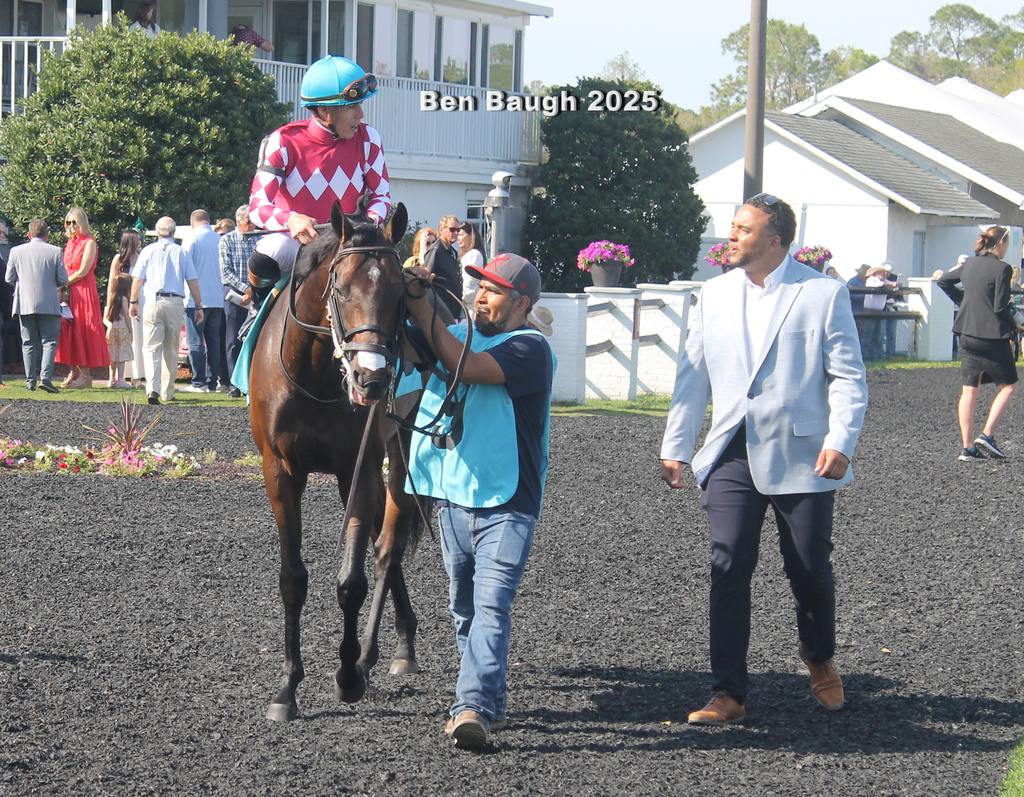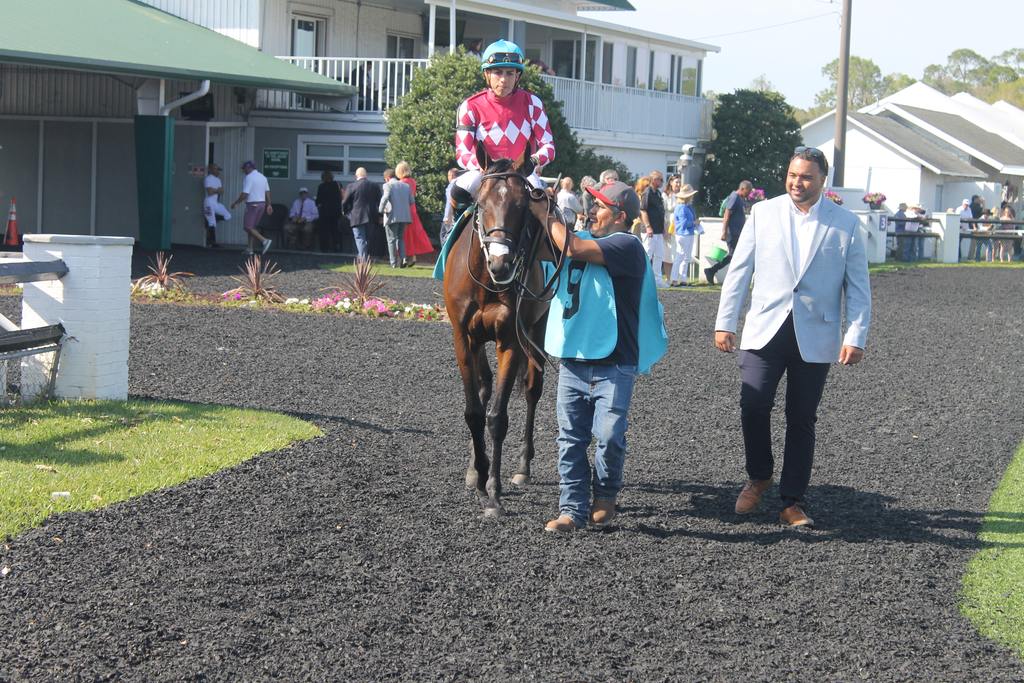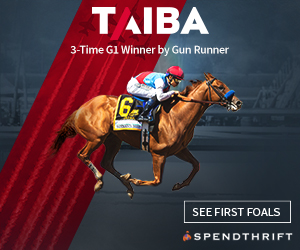
Irad Ortiz and Nick Tomlinson, Photo Courtesy of Ben Baugh
Ben Baugh
It’s hard to believe that Thoroughbred trainer Nick Tomlinson is only 31-year-old, his confidence, demeanor and maturity belie his age. However, maybe that’s what happens when you begin working at the racetrack at age 13 and make the necessary sacrifices to stay focused and committed to one’s dream.
Parental consent and a dream
Tomlinson’s father was working at Woodbine, as a groom and on the starting gate, and when he made his entrée onto the backside it was at a time when security was extremely tight and strict. His father was able to get someone to sigh Nick’s papers so he could begin his journey on the backside with his dreams ashis motivation, Tomlinson was more than up to the challenge of making his way in an adult world as someone in his early teens.
” A lot of times at the racetrack, it’s seven days a week,” said Tomlinson. “it’s long hours, and our time was basically spent there.”
Building the foundation
However, the person that signed Tomlinson’s license would play a pivotal role, launching his career, it was Thoroughbred trainer Peter Berringer, who Tomlinson would work for on the weekends and during the summer, providing him with a solid foundation that would serve him well as he moved forward, giving him ample opportunity to learn and grow.
“For Peter, probably his most mentionable horse I worked with was Court of the Realm,” said Tomlinson. “He ended up winning the Grade 2 King Edward Stakes. He was probably the first nice horse that I ever got to be around. There were definitely some others. Frobisher Bay, Mallory, Valeisha. The first horse that I ran for him, that I was allowed to run was named Kyoquot Sound. When I started working for Mark(Casse), he actually trained the sister down at Gulfstream. That was kind of cool to have that kind of connection.”
Aspiring talent
People began to notice the young horseman’s evolution and recognized the potential and the promise as Tomlinson began to make his way through an industry renowned for its hardscrabbleexistence. A propitious set of circumstances opened upopportunities where the ambitious young horseman’s growth gave him the confidence to push himself to greater limits that would allow him to reach a number of objectives, preparing for the future, one that was beginning to unfold.
“I was only supposed to work for Malcolm and Sally (Pierce) for a couple of weeks,” said Tomlinson. “I was in between jobs at the time. They were waiting on someone’s visa to be approved for them to start working. So, I started working for them, and Sally really took a liking to me. And when the guy’s visa got approved, she said, ‘I really like you, I’d like for you to stay on, would you mind hot walking, until we can find something for you?’ I was like, ‘sure.’ I stayed on, and kind of looked around for a grooming job, and then just by chance, somebody didn’t show up for work and quit, and that’s kind of how I got my opportunity grooming for them fulltime, and after about I would say a year, I expressed my interest in becoming an assistant. They allowed me to write my assistant trainer’s test, they didn’t really need anybody as an assistant, but they kind of saw something in me.”

Traveling and networking
The chance to work for the Pierces provided Tomlinson to go to different racetracks, giving him exposure and allowing him to network and meet other people within the Thoroughbred industry and one of those people would provide him with a life transforming experience.
“I did a lot of their traveling to the states, whenever they had a horse in,” said Tomlinson. “Malcolm would usually fly in so I would go there to take care of the horse. That allowed me to go to Keeneland, and when I was at Keeneland that’s where I met Mark (Casse).”
Timing is everything
If opportunity meets preparation, then Tomlinson was more than lucky when he went to work for the dual Hall of Fame conditioner, arriving at a time that was propitious and purposeful, working for an outfit whose barn was replete with stakes winners.
“I think I started working for Mark at the right time,” said Tomlinson. “He had just won his first two Breeders’ Cup races with Catch a Glimpse and Tepin. I started in Ocala with him. I probably took a lot of it for granted, looking back at it. Ocala wasn’t the place that I wanted to be at the time. I was 21 years old. There was nothing really to do in Ocala. It was a bit boring for me, and I was really itching to get to the racetrack. But to be around those kinds of horses is a whole different ball game. You learn a lot. You learn a lot about what it takes to get to the big races. You learn a lot about the horses in general.”
Classic connection
It was a son of Pioneer of the Nile, a three-time graded stakes winner as a juvenile, and winner of three Grade Ones, including a powerful performance during his sophomore campaign, that provided Tomlinson with some invaluable experience while working for Casse.
The colt campaigned by John Oxley won the Grade Three Bashford Manor as a juvenile and followed those victories with wins in the Claiborne Breeders’ Futurity (Gr. 1) and Sentient Jet Breeders’ Cup Juvenile (Gr. 1). A victory in the Grade One Arkansas Derby established him as a Triple Crown contender, eventually placing fourth in the Kentucky Derby Presented by Yum! Brands and second in the Preakness Stakes.
“I had the opportunity to be around Classic Empire as a 2-year-old, and the spring of his 3-year-old year,” said Tomlinson. “As everybody knows, he was very difficult to train, and looking back at it now, every horse that I’ve been around, I’ve learned something from, whether they’re $12,500 claimers to a Grade One winner, but a horse like him really teaches you a lot. I’m very fortunate to have been around a lot of Mark’s good horses, and very grateful for every opportunity that I’ve ever had.”
Realizing the dream
Tomlinson’s first victory since going out on his own won in impressive style on Oct. 31, with Ironhorse Racing Stable LLC’s and Tiger Racing’s Insolenta. The 4-year-old daughter of More Than Ready won by daylight, with a 10 ¼-length margin victory at Gulfstream Park. The victory was bittersweet as the filly was claimed by Heehaw Racing and is now in the barn of Jorge Degado.
“When my filly ran the other day she hit the wire first, everything kind of came full circle,” said Tomlinson. “I started literally from the bottom, being a hot walker, grooming, foreman/assistant, being the main assistant, and now being a trainer. Actually, I owned a couple of horses before I went on my own. Everything kind of came full circle. I think you appreciate it probably a lot more having to have gone through the daily grind and coming up, then to say it was handed to you because everybody in this industry works extremely hard, but just to start from where I did and make my way up was definitely gratifying.”
Finding the ideal place
The native of Toronto, Ont., Canada, is based at Palm Meadows in Boynton Beach, Fla., a facility he is familiar with, and will be based at during the Championship Meet at Gulfstream Park. Being based at Palm Meadows provided Tomlinson with the opportunity to watch the athletes evolve and mature, with many of the juveniles from Mark Casse’s program going on to achieve great things once leaving the facility, but often it was poignant as they were no longer in the barn and were at the races fulfilling their destiny.
“Palm Meadows is probably one of the best places to train in North America,” said Tomlinson. “It’s a beautiful facility, it’s very horse friendly, lots of grass, round pens, and you can see why it’s one of the premier destinations in the wintertime. I think the hardest part about training at Palm Meadows for Mark was the transition from the winter to the summer because the quality of horses was significantly different.
“I’ve had a great time being up at Palm Meadows, a lot of success, a lot of horses have come out of there, they’ve gone on to do well, and that’s the main thing. It’s almost like you’ve had your kid and they’re going off to school, especially with two-year-olds. I’ve had a few good 2-year-olds come out of there. It’s always nice to see them progress after they’ve left you to go on and do good things. Honestly, it’s just been great. It’s very horse friendly. Horses seem to do really well there, for me it’s the better place to be. I have to ship down on race day, but I still don’t think that you can beat it. I’m definitely glad that I’m at Palm Meadows.”
Learning from the best
If patience is a virtue and paying one’s dues over a period of years are part of the development process, Tomlinson has certainly put in the time to evolve as a horseman, while learning from some of the industry’s best, most competent and respected names, making the decision to go out on his own easier when the timing was right.
“I think for the past five years I’ve been contemplating making this move. I probably could’ve done it five years ago, but I kind of stopped myself, to a degree, do I regret it, maybe a little bit, but I think I’ve matured a lot as a person, and I’m probably in a better mind frame maturity-wise now than I would’ve been five years ago. It’s probably best that I did wait for this moment.”
Tomlinson has taken bits and pieces from everyone he’s worked for and with, his father, Peter Berringer, the Pierces and Mark Casse, and has incorporated those lessons he’s learned into his own program, providing him with a deep toolchest of resources as he’s now applying that knowledge to his own training program. It was Casse’s approach that Tomlinson has found to be invaluable when allowing horses to evolve into the athlete they’ll become.
” I’ve learned probably the most from being in the assistant role, Mark probably taught me the most when it came to racing in general,” said Tomlinson. “One of the famous sayings of Mark is, ‘You never know until you try. You can’t steal third if you’re afraid to get off of second.’ I can’t tell you how many times we’ve had a horse, and Mark will say, ‘well let’s just run it.’ I’m like Mark if this horse doesn’t show anything or especially when it comes to 2-year-olds. This horse doesn’t show anything, you can make up a thousand excuses, and that horse goes over there and runs well, or after that race, and all of a sudden, they’re a different horse, the lightbulb turns on, and I think in that aspect, being able to learn that from Mark has helped me a lot. I think I have a broader vision when it comes to horses and forgiving them in certain situations to be able to progress in their future.”
Making his way
However, Tomlinson’ drive and competitiveness also play a large role in his success and reaching the objectives he’s set for himself, understanding what it requires to be successful in a challenging industry, while putting the best interests of the horse first.
“When I worked for Peter, I’ve always wanted one better, one more, I think working for him installed a great work ethic in myself,” said Tomlinson. “I consider myself to be a very hard worker. When you’re a smaller operation you work more as a team, and you do everything together to get the job done. I think it makes more work for everybody but learning that at a young age has helped me move on and being able to keep that work ethic, has helped me throughout the years. Malcolm and Sally, I think I learned a lot about horsemanship working for them, and how to treat people. Sally and Malcolm, they were phenomenal people to work for. They always treated you like family. That’s the one thing I can say about them, they were one in a million.”
Dreaming big
Tomlinson’s desire and passion are palpable, and his love for the sport is apparent when he talks about his objectives, long-term and short-term, wanting to make it to the top tier.
“I’d love to be winning Breeders’ Cups, having horses in the Kentucky Derby, Dubai World Cup, Saudi Cup, all the big races, that’s always the goal,” aid Tomlinson. “You want to be one of the best. You want to be up there against the best, the Chad’s, the Brad’s, the Todd’s and Mark’s of the game. Being from Canada, my dad’s an immigrant, he’s from Barbados. I don’t only want to win races in America; I want to win races in Canada. I want to win the Sandy Lane Gold Cup in Barbados. I have all these dreams and goals, hopefully within the next five to 10 years, I can make that happen.”
Going home again
Thoroughbred racing has enabled Tomlinson the opportunity to travel, but there’s also no place like home, and there are times when he thinks about when he began working on the backside, to where his career has taken him.
“Woodbine is where everything started,” said Tomlinson. “I miss Tim Horton’s daily. I haven’t been able to go back to Woodbine as much as I would like. Hopefully now, I’ll be able to, training on my own. Hopefully, it opens up some avenues to where I’m able to run up at Woodbine, I think that would be probably one of the coolest things that I’ll probably experience.”
Sacrifice and success
The long hours, being a teenager in an adult’s world at an early age, meant a great deal of sacrifice, but the dedication, perseverance and commitment has paid dividends, and allowed him to achieve objectives at an early age, where Tomlinson appears to be poised for a bright future.
“I think starting at such a young age, I probably grew up faster than a lot of people, seeing where I’m at today, I definitely don’tregret it, said Tomlinson. Obviously, there were times when my friends went to the club, and I was going to work when they were coming home. I was so focused on making it, and in my career, I probably gave up a lot of the childhood stuff, but to see where I’m at now, I definitely wouldn’t change it.”



